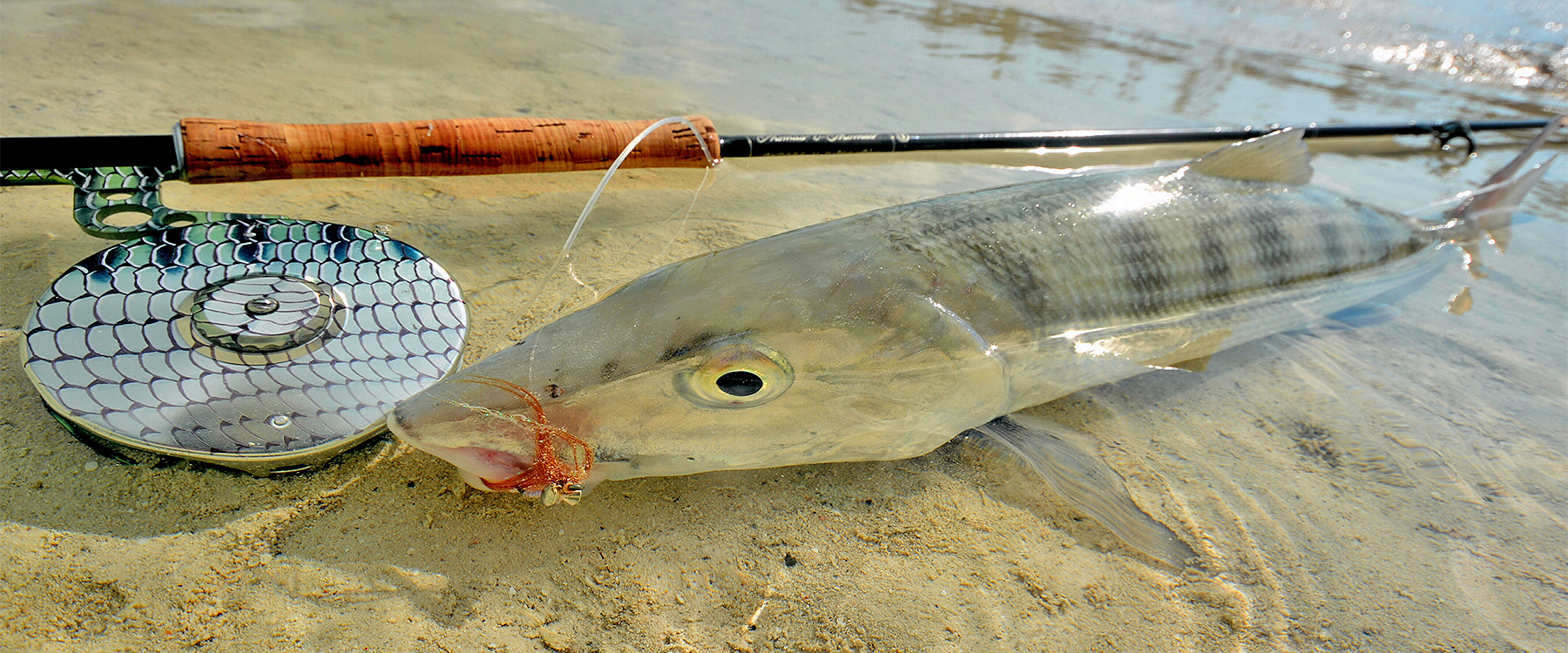Albula vulpes – Bonefish
by
Eric Ersch & Pat Pendergast
More fly fishers got their start in saltwater fly fishing pursuing bonefish than any other species. One of the nice things about bonefishing is that the proper equipment needed to catch them successfully often comes down to common fly rod weights and size — a nine foot seven or eight weight. Throw in a decent fly reel filled with plenty of backing, a fly line, and some flies, and you are pretty much good to go. Obviously, if saltwater fly fishing becomes your gig, your gear will get more refined, but to get started bonefishing, your bass or heavy trout rod will get the job done.
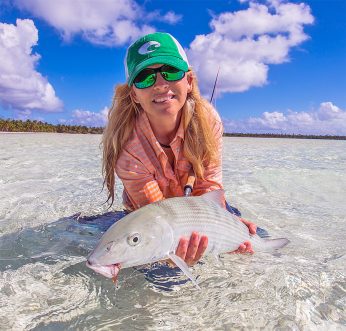 Another aspect of bonefishing that makes it more approachable to fly fishers is that you can wade fish for bones, just like you would for trout. There are similarities between wading along a spring creek hunting trout and wading a flat stalking bonefish: stealth, accuracy, presentation, and spotting fish are all part of the pursuit.
Another aspect of bonefishing that makes it more approachable to fly fishers is that you can wade fish for bones, just like you would for trout. There are similarities between wading along a spring creek hunting trout and wading a flat stalking bonefish: stealth, accuracy, presentation, and spotting fish are all part of the pursuit.
In comparison, fly fishing for permit, tarpon, and snook are usually done from a poled skiff. Fishing from a boat is not easy; everything is moving — the boat, the guide, the fish, the tide, wind, and the angler — so there are a lot of dynamics to contend with. But by wading you cut the amount of moving objects by at least half.
So why bonefish and not tarpon, permit, snook, trevally, or some other species of fish that frequent the flats? It’s simple: numbers. Bonefish have a very wide range of distribution from the central and south Pacific, including Hawaii, Florida, the Bahamas, the Gulf of Mexico, Antilles, throughout the Caribbean down to Brazil, as well as some West African waters, and in areas of the Indian Ocean. Sure some spots are known for big bonefish and others for smaller fish (schoolies), but generally speaking, bonefish are present in good numbers on the flats, and they are aggressive feeders.
If you have dreamt about getting into saltwater fly fishing, then we suggest you start with bonefish as your target species. We recommend that you start with a destination that has a lot of bonefish, like Belize, the Yucatan Peninsula of Mexico, or Christmas Island. You want a target-rich environment, and if you blow a shot, it’s no big deal because you might get 10 or more in the next hour, and practice makes perfect. Later on, when you have some experience under your belt, you can branch out and start pursuing other flats species like tarpon, permit, and snook.
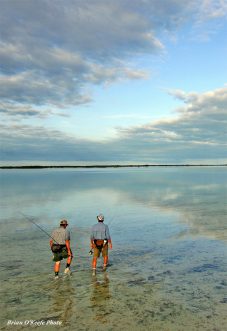 Bonefishing Techniques
Bonefishing Techniques
On the flats, your guide will be standing on the poling platform and poling the boat while scanning for fish. You will be standing on the front deck of the boat with your rod in one hand and your fly in the other.
When you are not fishing from the boat, you will be wading the flats. When wading, walk slowly, and stop often to look for fish. If you see the fish moving in a specific direction, move quietly into position so that you can present the fly in front of the fish. You usually have more time than you think to make a precise presentation, especially when wade fishing.
Bonefish are almost always moving, and movement is often the first sign of fish. Scan the water slowly from side to side, within the range that you can cast. The guide, responsible for finding fish at a distance and moving into a good casting position, will be looking farther out. Look for the flash of an exposed tail, nervous water, a wave or wake on top of the water, or the shadow of a cruising fish. When casting to a fish that is moving toward you, land the fly in front of the fish, let it sink while the fish moves toward it, and begin stripping when the fish is close to the fly.
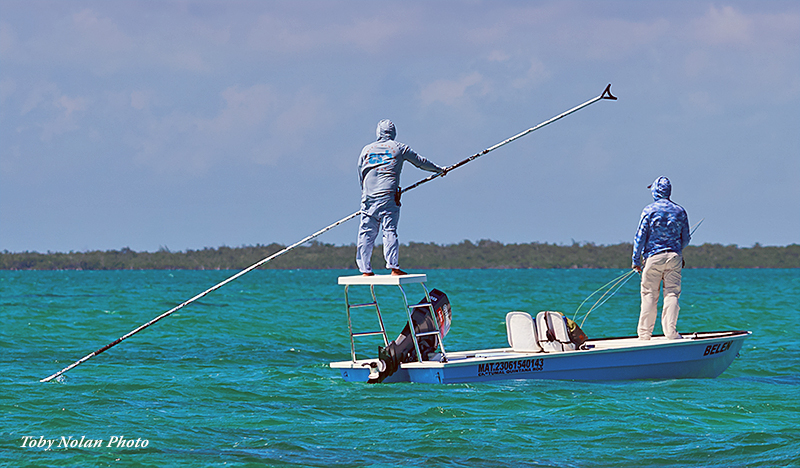
Typically the guide will see the fish before you and will put the boat or you in position for your cast. You will hear the guide direct you to the fish by saying something like, “10 o’clock, 40 feet, going left.” Point your rod where you think he is directing you, and he will often help by saying, “more left” or “more right,” and tell you when to cast.
If you do not see the fish, do not cast until your guide asks you to. Your guide will put the boat or you in position for the cast, tell you how far to cast and in which direction, and when to cast. Follow the directions for when to begin stripping your fly and what type of strip will entice the fish to eat your fly.
After you cast, let the fly sink to the bottom, and make your first strips long and slow to get the fish’s attention. Now you are going to “read the fish” by observing its behavior. If it moves quickly to your fly and stops, it probably ate your fly. Make a long strip to set the hook. If there is no resistance, stop, let the fly sink, and begin stripping again. If you do feel resistance, pull on your line to set the hook without lifting your rod, and prepare to “clear your line to the reel” as the fish runs. The first run often takes all the line quickly off the deck or water surface, and it is important that you guide the free line back onto the reel. Your drag has been pre-set, so hold your rod tip high and enjoy the run! Occasionally the fish will turn and run towards you. If you can’t reel or strip fast enough to keep a tight line, put your rod tip into the water and the drag of the fish pulling the line through the water will keep tension on the hook.
Bonefish have tough mouths and having sharp hooks is important. Check your hook point regularly by pulling it across your thumb nail. If it digs into your nail, it’s sharp. If it drags across your nail without sticking, it’s time to sharpen the point. Be certain to pinch down the barbs on your hooks. This makes it easier to release fish with minimal handling, and it also minimizes the risk of injury to yourself and others. Now you have successfully spotted, stalked, hooked, and released your first bonefish. The best thing about it is that you get to do it again and again…
Bonefish Behavior
Bonefish are the target species in the Bahamas, Belize, Mexico, Honduras, the Seychelles, and the central and south Pacific, including Christmas Island, and they have three basic modes of behavior.
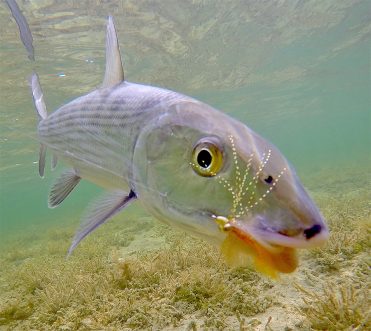 Feeding
Feeding
Bonefish feed on the bottom and through the water column. While feeding on very shallow flats, their wavering tails are often visible out of the water – “tailing bones”. In deeper water their tails are not visible, but the fish can still be seen. While bonefish are feeding, the condition of the surface of the water affects their feeling of security. Bonefish are more nervous in calm water. Conditions determine how best to present the fly. On most days there is a slight chop or ripple on the surface, and the fly must be presented three to five feet in front of them. On very still days, the fly should be cast farther from the fish and stripped back into its field of vision and area of awareness.
Mudding
During the warmer months, very large schools of bonefish will often back off the shoreline into about five to 10 feet of cooler water. As they grub for food, they stir up the bottom, which creates a visible cloud of mud, referred to as “milk.” This cloud of mud moves as the bonefish move, making them feel quite secure because they are not visible to predators. Often the angler can catch one fish after another without spooking the school. It is generally not a common practice to fish muds because the desired challenge of sight fishing is eliminated. However, guides will fish muds with you at your request, and this can be good for beginners to feel the first lightning-fast tug of a bonefish.
Traveling
Traveling bonefish are intent on changing location, but they are very aware of their surroundings and not necessarily interested in feeding. When casting to traveling bonefish, place your offering well ahead of the fish and let it settle. Your guide will tell you when the fish is in range and when to strip.
Planning & Preparing for Your Trip
The best thing you can do to get ready after booking your bonefishing trip is to practice your casting. Accuracy of cast is far more important than distance. Speed of re-casting is also very important as saltwater fish tend to move across the flats. If you have an accurate 40-foot cast and can pick that fly up and re-cast (for example, from 12 o’clock to 2 o’clock to get in front of a moving school of fish), this is far better and will hook more fish than a wild 60-foot cast.
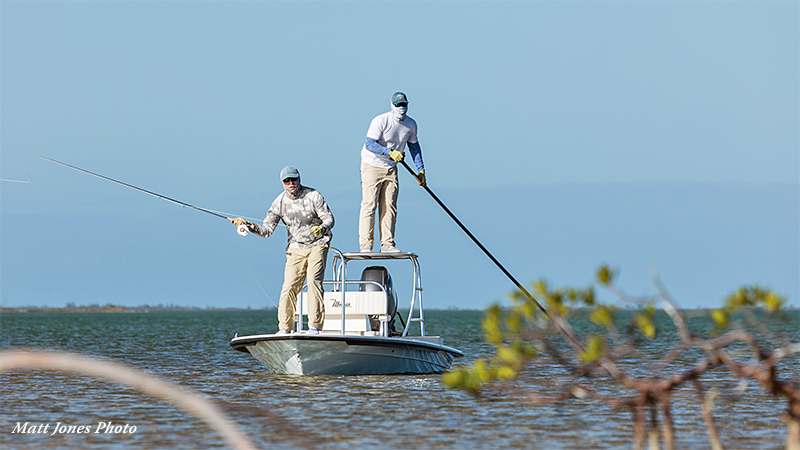
Your guides are there not only to get you into fish but to help make your fishing trip go as smoothly as possible. They are well-versed in fly fishing and know their fishing grounds well. Some guides tend to be a bit more shy than others and don’t want to be presumptuous, so if you need something, let them know. If you need help with your casting, most guides are experienced in fly casting and fly fishing tackle. The guides will also make fly recommendations and help rig rods.
When fishing, you are on the bow of the skiff and the guide is normally on the platform at the aft. Guides use the “clock” system and foot measurements to help you locate fish. If standing facing forward on the skiff, the bow is 12 o’clock, hard right is 3 o’clock, and hard left is 9 o’clock. For foot measurements, your fly rod is approximately 9-feet. Your guide should go over this before fishing so you are both referring to the same thing.
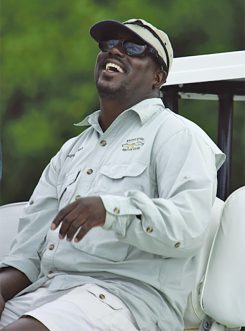 And finally, guides are people and none have the same personalities. Most guides know fishing and the areas to fish, and most guides will work hard to get you into fish. They like when you catch fish as much as you do, if not more so. If your guide is not living up to your expectations or not putting in the effort needed for an enjoyable day on the flats, please speak with the fishing manager. Sometimes the weather or the fish themselves are not cooperative, and this is not the guide’s fault. Working harder to find fish in bad weather conditions is what a good and hard-working guide does.
And finally, guides are people and none have the same personalities. Most guides know fishing and the areas to fish, and most guides will work hard to get you into fish. They like when you catch fish as much as you do, if not more so. If your guide is not living up to your expectations or not putting in the effort needed for an enjoyable day on the flats, please speak with the fishing manager. Sometimes the weather or the fish themselves are not cooperative, and this is not the guide’s fault. Working harder to find fish in bad weather conditions is what a good and hard-working guide does.
Suggested Reference Books:
- Practical Fishing Knots II by Mark Sosin & Lefty Kreh
- Fly Fishing in Saltwater by Lefty Kreh
- Fishing the Flats by Sosin & Kreh
- Fly Fishing for Bonefish by Dick Brown
- Saltwater Fly Fishing by Jeff Currier
- Fly Fishing for Bonefish by Chico Fernandez


